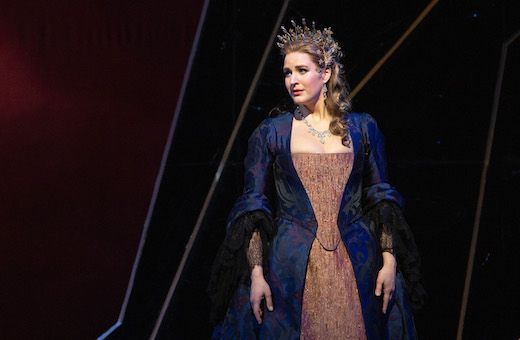Ariadne auf Naxos, in which “the richest man in Vienna” has commissioned an evening's entertainment made up of a commedia dell'arte performance and a tragic opera, brings together the concepts of high art and “frivolous” comedy. In the Prologue we are backstage with the horrified Composer of the opera, all of the performers getting in one another's way. The Music Master works with and calms the Composer. By the end of the Prologue, the notion has become even worse – the rich man wants the evening's two parts to be performed at the same time. The absurd thing about this is that we, the audience, play the role of the Rich Man's guests, and we are going to witness this mishmash.
It's a strange pill to swallow, but Richard Strauss and librettist Hugo von Hofmannsthal crafted a tight, see-through, unsentimental evening that just rolls out in front of us, and our reactions mirror those of the players and singers in not-quite-knowing where this might go. Of course, it goes brilliantly; after all, it is Strauss and von Hofmannsthal, even if they bickered about it just about up to its premiere and beyond.
Elijah Moshinsky's 1993 Metropolitan Opera production on Michael Yeargan's sets has been revived a half dozen or more times and it always delights. The backstage shenanigans know precisely when to halt long enough to focus on the Composer's misery and travail, and eventually we feel great sympathy for the put-upon Composer. The Met this season has the fine Isabel Leonard, who nonetheless does not conquer the role's combination of sensitivity, vulnerability and arrogance. She was underpowered and strained, and the role fits uncomfortably in her voice. One must return to the grander Tatyana Troyanos, Evelyn Lear or Joyce DiDonato for ideal performances. Baritone Wolfgang Brendel played a truly self-important and unbending Major Domo (a spoken role) while Johannes Martin Kränzle's Music Master helped our Composer along as best he could.
But the news of the evening was elsewhere. The curtain rises on the Opera. Ariadne, a regal-seeming figure, is roaming and weeping among rocks. Suddenly three Nymphs in towering multi-colored skirts float in, ten feet tall. They lament in delicate, intertwined high coloratura. It's whimsical, clever and lovely to look at and hear. Ariadne begins at the bottom of her voice, in a sort of dirge, and the gaily-dressed troupe of players pop in and wonder how they will be able to cheer her up. But then, Lise Davidsen, our Ariadne, opens up and it's as if the room has a pulse. The depths are dark and severe; the middle of the voice solid enough for perfect diction and pitch, and the performance as a whole, that of a goddess. Her luminous top notes, perfect extensions of the rest of the voice, almost sound unreal, perfect pillars of sound emanating from other perfect pillars of sound. It is almost tangible. A slight bite comes into her sound above mezzo-forte – her pianissimo singing is haunting and is supported by columns of air – allowing the notes and text to push through whatever instrumentation is in the way.
Ariadne's big aria, “Es gibt ein Reich”, moves organically from a dreamy narrative on the purity of death to a passionate death wish, the voice rising to a series of high B flats the likes of which have not been heard at the Met in years. Secure, beautiful, rounded and sung with a perfect legato and sense of line, the brilliance is close to Birgit Nilsson's but with a warmth of, say, Margaret Price. The final duet, with a one-dimensional Bacchus who shows up in the place of Death, for whom she's been waiting, can be a trial; it's very high, it's repetitive, the orchestration can be rambunctious. Here, joined by a marvelous, ringing, elegant Brandon Jovanovich (who refused to push for volume) the audience was transformed by Davidsen at full throttle. Wearing a blue gown and a tiara, the six-feet, two-inch Norwegian was every inch the goddess. The roar at her solo call was visceral – the house rumbled.

Zerbinetta, the star of the band of players, of course, gets her own 12-minute showpiece and Brenda Rae, petite and energetic, sang the bejeezus out of it – long lines of coloratura, exclamatory singing, upward scales, high Cs, Ds and E flats right in the middle. The voice sounded small but stunning, and the effect was marvelous. Her four-man troupe of Sean Michael Plumb, Ryan Speedo Green, Alok Kumar and Miles Mykkanen were mellifluous and playful.
Marek Janowski, back at the Met after 33 years, led with such modesty and lack of eccentricity that the music seemed to play itself. From the piano popping out from the orchestral fabric in the Prologue to the dark, foreboding strings that open the opera and the winds that seem to be chatting about the characters, the chamber-like moments worked as well as the grandeur of the finale.
Davidsen sings Chrysothemis here, beginning next month. She is a singer for the ages.


